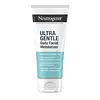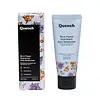What's inside
What's inside
 Key Ingredients
Key Ingredients

 Benefits
Benefits

 Concerns
Concerns

 Ingredients Side-by-side
Ingredients Side-by-side

Water
Skin ConditioningGlycerin
HumectantDicaprylyl Ether
EmollientCaprylic/Capric Triglyceride
MaskingNiacinamide
SmoothingCetyl Alcohol
EmollientCentella Asiatica Extract
CleansingPanthenol
Skin ConditioningTocopheryl Acetate
AntioxidantStearic Acid
CleansingPalmitic Acid
EmollientButylene Glycol
HumectantCaprylyl Glycol
EmollientCetearyl Alcohol
EmollientDimethicone
EmollientCeteareth-20
CleansingCarbomer
Emulsion StabilisingPhenoxyethanol
PreservativeChlorphenesin
AntimicrobialSodium Hydroxide
BufferingSodium Citrate
BufferingCitric Acid
BufferingWater, Glycerin, Dicaprylyl Ether, Caprylic/Capric Triglyceride, Niacinamide, Cetyl Alcohol, Centella Asiatica Extract, Panthenol, Tocopheryl Acetate, Stearic Acid, Palmitic Acid, Butylene Glycol, Caprylyl Glycol, Cetearyl Alcohol, Dimethicone, Ceteareth-20, Carbomer, Phenoxyethanol, Chlorphenesin, Sodium Hydroxide, Sodium Citrate, Citric Acid
Water
Skin ConditioningEthylhexyl Methoxycinnamate
UV AbsorberEthylhexyl Salicylate
UV AbsorberPropylene Glycol
HumectantTitanium Dioxide
Cosmetic ColorantNiacinamide
SmoothingParaffinum Liquidum
EmollientCetearyl Alcohol
EmollientPolysorbate 60
EmulsifyingStearyl Alcohol
EmollientBis-Ethylhexyloxyphenol Methoxyphenyl Triazine
Skin ConditioningSynthetic Beeswax
Emulsion StabilisingMagnesium Aluminum Silicate
AbsorbentPalmitic Acid
EmollientStearic Acid
CleansingSorbitan Stearate
EmulsifyingGlyceryl Stearate
EmollientPEG-100 Stearate
Ethylhexyl Triazone
UV AbsorberGlyceryl Stearate Se
EmulsifyingBetula Alba Juice
AstringentDimethicone
EmollientHydrogenated Vegetable Oil
EmollientOzokerite
Emulsion StabilisingPhenoxyethanol
PreservativeParfum
MaskingTriethanolamine
BufferingLithium Magnesium Sodium Silicate
AbsorbentEthylhexylglycerin
Skin ConditioningButylene Glycol
HumectantXanthan Gum
EmulsifyingChamomilla Recutita Flower Extract
MaskingHydrogenated Palm Acid
Stearyl Stearate
EmollientAdenosine
Skin Conditioning1,2-Hexanediol
Skin ConditioningDisodium EDTA
Quartz
AbrasivePassiflora Incarnata Flower Extract
Skin ConditioningCyclomethicone
EmollientDipropylene Glycol
HumectantMagnesium Ascorbyl Phosphate
AntioxidantHippophae Rhamnoides Oil
EmollientCI 42090
Cosmetic ColorantWater, Ethylhexyl Methoxycinnamate, Ethylhexyl Salicylate, Propylene Glycol, Titanium Dioxide, Niacinamide, Paraffinum Liquidum, Cetearyl Alcohol, Polysorbate 60, Stearyl Alcohol, Bis-Ethylhexyloxyphenol Methoxyphenyl Triazine, Synthetic Beeswax, Magnesium Aluminum Silicate, Palmitic Acid, Stearic Acid, Sorbitan Stearate, Glyceryl Stearate, PEG-100 Stearate, Ethylhexyl Triazone, Glyceryl Stearate Se, Betula Alba Juice, Dimethicone, Hydrogenated Vegetable Oil, Ozokerite, Phenoxyethanol, Parfum, Triethanolamine, Lithium Magnesium Sodium Silicate, Ethylhexylglycerin, Butylene Glycol, Xanthan Gum, Chamomilla Recutita Flower Extract, Hydrogenated Palm Acid, Stearyl Stearate, Adenosine, 1,2-Hexanediol, Disodium EDTA, Quartz, Passiflora Incarnata Flower Extract, Cyclomethicone, Dipropylene Glycol, Magnesium Ascorbyl Phosphate, Hippophae Rhamnoides Oil, CI 42090
 Reviews
Reviews

Ingredients Explained
These ingredients are found in both products.
Ingredients higher up in an ingredient list are typically present in a larger amount.
Butylene Glycol (or BG) is used within cosmetic products for a few different reasons:
Overall, Butylene Glycol is a safe and well-rounded ingredient that works well with other ingredients.
Though this ingredient works well with most skin types, some people with sensitive skin may experience a reaction such as allergic rashes, closed comedones, or itchiness.
Learn more about Butylene GlycolCetearyl alcohol is a mixture of two fatty alcohols: cetyl alcohol and stearyl alcohol. It is mainly used as an emulsifier. Emulsifiers help prevent the separation of oils and products. Due to its composition, it can also be used to thicken a product or help create foam.
Cetearyl alcohol is an emollient. Emollients help soothe and hydrate the skin by trapping moisture.
Studies show Cetearyl alcohol is non-toxic and non-irritating. The FDA allows products labeled "alcohol-free" to have fatty alcohols.
This ingredient is usually derived from plant oils such as palm, vegetable, or coconut oils. There is debate on whether this ingredient will cause acne.
Due to the fatty acid base, this ingredient may not be Malassezia folliculitis safe.
Learn more about Cetearyl AlcoholDimethicone is a type of synthetic silicone created from natural materials such as quartz.
What it does:
Dimethicone comes in different viscosities:
Depending on the viscosity, dimethicone has different properties.
Ingredients lists don't always show which type is used, so we recommend reaching out to the brand if you have questions about the viscosity.
This ingredient is unlikely to cause irritation because it does not get absorbed into skin. However, people with silicone allergies should be careful about using this ingredient.
Note: Dimethicone may contribute to pilling. This is because it is not oil or water soluble, so pilling may occur when layered with products. When mixed with heavy oils in a formula, the outcome is also quite greasy.
Learn more about DimethiconeNiacinamide is a multitasking form of vitamin B3 that strengthens the skin barrier, reduces pores and dark spots, regulates oil, and improves signs of aging.
And the best part? It's gentle and well-tolerated by most skin types, including sensitive and reactive skin.
You might have heard of "niacin flush", or the reddening of skin that causes itchiness. Niacinamide has not been found to cause this.
In very rare cases, some individuals may not be able to tolerate niacinamide at all or experience an allergic reaction to it.
If you are experiencing flaking, irritation, and dryness with this ingredient, be sure to double check all your products as this ingredient can be found in all categories of skincare.
When incorporating niacinamide into your routine, look out for concentration amounts. Typically, 5% niacinamide provides benefits such as fading dark spots. However, if you have sensitive skin, it is better to begin with a smaller concentration.
When you apply niacinamide to your skin, your body converts it into nicotinamide adenine dinucleotide (NAD). NAD is an essential coenzyme that is already found in your cells as "fuel" and powers countless biological processes.
In your skin, NAD helps repair cell damage, produce new healthy cells, support collagen production, strengthen the skin barrier, and fight environmental stressors (like UV and pollution).
Our natural NAD levels start to decline with age, leading to slower skin repair, visible aging, and a weaker skin barrier. By providing your skin niacinamide, you're recharging your skin's NAD levels. This leads to stronger, healthier, and younger looking skin.
Another name for vitamin B3 is nicotinamide. This vitamin is water-soluble and our bodies don't store it. We obtain Vitamin B3 from either food or skincare. Meat, fish, wheat, yeast, and leafy greens contain vitamin B3.
The type of niacinamide used in skincare is synthetically created.
Learn more about NiacinamidePalmitic Acid is a fatty acid naturally found in our skin and in many plant and animal sources. In cosmetics, it is usually derived from palm oil. It serves many purposes in skincare, acting as a cleanser, emollient, and emulsifier.
As an emollient, palmitic acid helps soften and smooth the skin by preventing water loss. In cleansers, it helps remove oil and dirt while creating foam.
Its emulsifying properties help stabilize products by keeping water and oil-based ingredients from separating.
This may not be suitable for fungal acne-prone skin, as fatty acids like this can sometimes trigger breakouts in sensitive individuals.
Learn more about Palmitic AcidPhenoxyethanol is a preservative that has germicide, antimicrobial, and aromatic properties. Studies show that phenoxyethanol can prevent microbial growth. By itself, it has a scent that is similar to that of a rose.
It's often used in formulations along with Caprylyl Glycol to preserve the shelf life of products.
Stearic Acid is a fatty acid. It is an emollient, emulsifier, and texture enhancer.
As an emollient, stearic acid helps soften skin. It aids the skin's protective barrier by preventing water loss. It also provides a gentle cleansing effect without stripping away natural oils.
Stearic acid may also be used to enhance the texture of products. It can add volume and stabilize ingredients such as water and oil. This can help water and oil ingredients from separating.
Sources of stearic acid include animal or vegetable fats/oils such as coconut or shea. It can be naturally found in butter, cocoa butter, shea butter, vegetable fats, and animal tallow.
This ingredient may not be Malassezia folliculitis, or fungal-acne safe.
Learn more about Stearic AcidWater. It's the most common cosmetic ingredient of all. You'll usually see it at the top of ingredient lists, meaning that it makes up the largest part of the product.
So why is it so popular? Water most often acts as a solvent - this means that it helps dissolve other ingredients into the formulation.
You'll also recognize water as that liquid we all need to stay alive. If you see this, drink a glass of water. Stay hydrated!
Learn more about Water